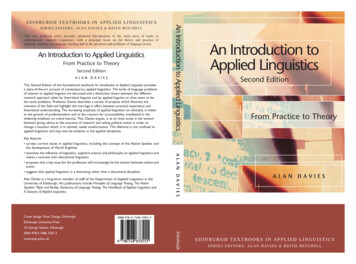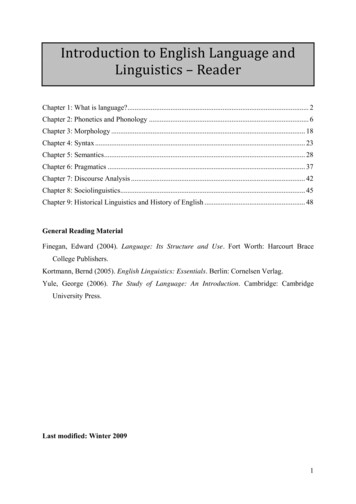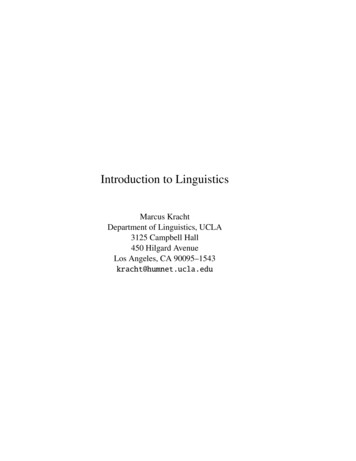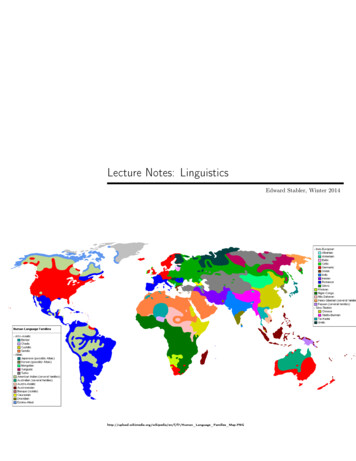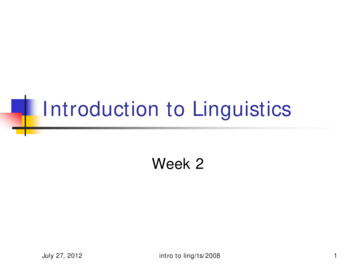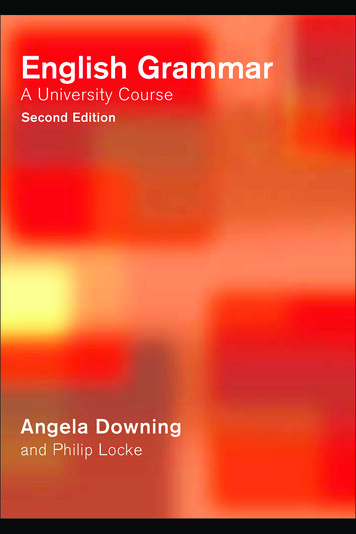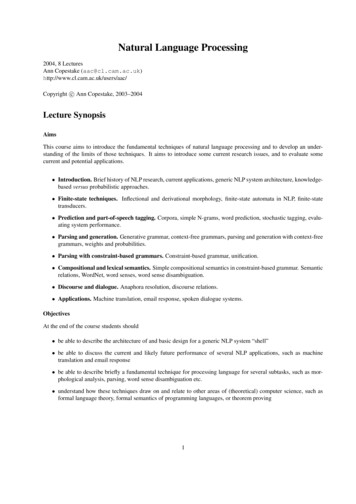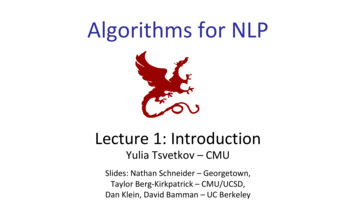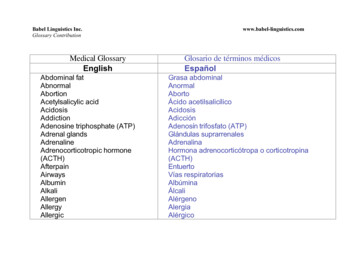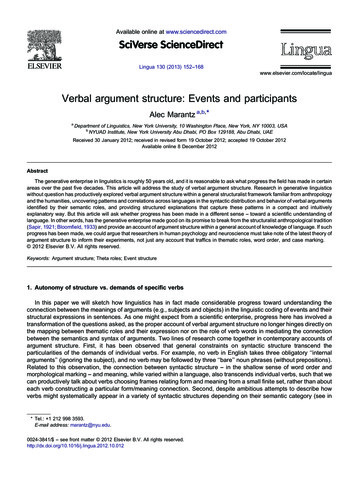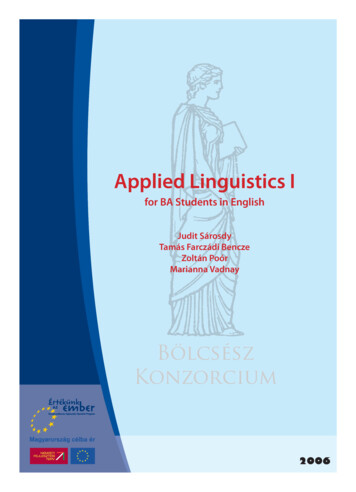
Transcription
Applied Linguistics Ifor BA Students in EnglishJudit SárosdyTamás Farczádi BenczeZoltán PoórMarianna VadnayBölcsészKonzorcium2006120-cimlap.indd 12006.07.20. 15:17:40
JUDIT SÁROSDYTAMÁS FARCZÁDI BENCZEZOLTÁN POÓRMARIANNA VADNAYAPPLIED LINGUISTICS Ifor BA Students in English1
2
JUDIT SÁROSDYTAMÁS FARCZÁDI BENCZEZOLTÁN POÓRMARIANNA VADNAYAPPLIED LINGUISTICS Ifor BA Students in EnglishBÖLCSÉSZ KONZORCIUM20063
Chapters 12 and 13 were compiled by Marianna Vadnay.Chapters 10 and 14 were compiled by Zoltán Poór.All other chapters were compiled byJudit Sárosdy and Tamás Farczádi Bencze.Kiadta a Bölcsész KonzorciumA Konzorcium tagjai:Eötvös Loránd TudományegyetemPécsi TudományegyetemSzegedi TudományegyetemDebreceni EgyetemPázmány Péter Katolikus EgyetemBerzsenyi Dániel F iskolaEszterházy Károly F iskolaKároli Gáspár Református EgyetemMiskolci EgyetemNyíregyházi F iskolaVeszprémi EgyetemKodolányi János F iskolaSzent István EgyetemSzakmai lektor: Kissné Gulyás JuditISBN 963 9704 94 6 Bölcsész Konzorcium. Minden jog fenntartva!A kötet megjelenése az Európai Unió támogatásával,a Nemzeti Fejlesztési terv keretében valósult meg:A fels oktatás szerkezeti és tartalmi fejlesztéseHEFOP-3.3.1-P.-2004-09-0134/1.04
TABLEOFCONTENTSINTRODUCTION 9 .111. FORMER METHODS IN TEACHING ENGLISH 111.1. The Grammar Translation Method . 111.2. The Direct Method. 121.3. The Audio-Lingual Method . 131.4. The Silent Way . 151.5. Suggestopedia . 171.6. Community Language Learning . 181.7. Total Physical Response (TPR). 202. THE COMMUNICATIVE APPROACH222.1. Communication. 222.2. Characteristics of communicative classes:. 232.3. Defining Communicative Competence. 233. PARTICIPANTS OF LEARNING PROCESS 263.1. Teacher’s roles, teaching styles. 263.1.1. Controller. 263.1.2. Organiser . 263.1.3. Assessor. 273.1.4. Prompter . 273.1.5. Participant. 283.1.6. Resource . 283.2. Learner types. 283.2.1. The Age of Learners . 283.2.2. Learner differences . 323.2.2.1. Neuro-linguistic programming – Revell and Norman (1997) . 323.2.2.2. Multiple intelligences theory – Gardner (1983) . 323.2.2.3. Learning styles according to Willing (1987) . 334. CLASSROOM MANAGEMENT 354.1. Classroom interaction. 354.2. Classroom dynamics . 384.3. Classroom arrangement – various work-forms in classes. 394.3.1. Whole class grouping (Frontal/Lockstep) . 404.3.2. Individualised learning . 404.3.3. Pairwork . 414.3.4. Groupwork. 414.4. Discipline problems. 424.4.1. Discipline. 424.4.2. Why discipline problems occur . 434.4.3. The teacher’s role in maintaining discipline. 444.4.3.1. How to prevent disruptive behaviour . 444.4.3.2. Dealing with the rising problems. 455
4.4.3.3. When the problem has exploded . 454.5. Classroom management techniques . 464.5.1. Techniques. 465. LANGUAGE SKILLS485.1. A language teaching model . 485.1.1. Input. 485.1.1.1. Roughly-tuned Input. 485.1.1.2. Finely-tuned Input . 485.1.2. Output . 495.1.2.1. Practice output . 495.1.2.2. Communication output . 495.2. Classification of language skills . 515.2.1. Receptive Skills . 535.2.1.1. Reasons for reading and listening. 535.2.1.2. Sub-skills of Receptive Skills. 535.2.1.3. Methodological Principles for Teaching Receptive Skills . 545.2.1.3.1. The content of the texts . 545.2.1.3.2. Methodological Steps of Developing Receptive Skills . 555.2.2. Productive Skills. 575.2.2.1. Speaking . 575.2.2.2. Writing. 605.2.2.3. Translation . 645.2.2.4. Interpreting . 666. Vocabulary696.1. Selecting Vocabulary . 696.2. What does it mean to know a word? . 696.3. Active and Passive Vocabulary. 716.4. Presenting Vocabulary . 726.5. Using dictionaries. 737. GRAMMATICAL STRUCTURES 747.1. The presentation of structures. 748. PRONUNCIATION 788.1. When to teach pronunciation?. 788.2. The areas of pronunciation . 798.2.1. Individual sounds. 798.2.2. Stress. 808.2.3. Intonation. 808.2.4. Connected speech and fluency . 818.3. What materials to use to improve students’ pronunciation?. 819. CULTURE IN TEACHING ENGLISH 839.1. The definition of culture. 839.2. The domains of culture. 849.3. What culture do we teach?. 849.3.1. The importance of teaching achievement culture (‘big C’). 856
9.3.1.1. The objectives of teaching achievement culture. 859.3.2. The importance of teaching behaviour culture (‘small c’) . 869.3.3. The concepts belonging to the third area of culture . 869.4. Why to teach culture?. 869.5. Goals of teaching culture. 8710. VISUAL, AUDIO, AUDIO-VISUAL AND DIGITAL AIDS 8910.1. Basic principles of using tools in foreign language classes . 8910.2. Visuals and techniques of visualisation. 9010.3. Audio resources and ways of audio-production. 9410.4. Audio-visual means of education and approaches to video-production10110.5. Information and communication technologies . 10711. PLANNING 11011.1. General principles of course design. 11011.2. General principles of syllabus design. 11211.2.1. Planning a syllabus . 11211.2.2. Types of syllabuses. 11311.3. Short-term planning – Lesson plans . 11511.3.1. Pre-planning . 11511.3.2. The plan . 11611.3.3. A sample lesson plan . 11812. FEEDBACK AND ERROR CORRECTION 11912.1. Feedback . 12112.2. Kinds of feedback. 12112.3. Error correction. 12112.4 Errors versus mistakes . 12212.4.1. Mistakes. 12212.4.2. Slips and attempts. 12212.4.3. Performance versus competence . 12212.4.4. Errors . 12212.5. Teachers’ attitude to errors . 12312.5.1. Interlanguage . 12312.6. What are the most important causes of errors?. 12312.6.1. Language transfer - interference. 12412.6.2. Intraference. 12412.6.3. Overgeneralization. 12412.6.4. Teaching-induced errors . 12412.7. Types of errors . 12512.8. Responding to oral errors . 12512.8.1. Accuracy. 12612.8.2. Indication of incorrectness. 12712.8.3. Ways of correction. 12712.8.4. Fluency . 12812.9. Correction of written errors . 12913. EVALUATION 1317
13.1. Assessment. 13113.1.1 Forms of assessment. 13113.2. Measurement. 13213.3. Tests . 13213.4. Criteria of good tests. 13313.4.1. Validity . 13313.4.2. Reliability . 13413.4.2.1. Reliability of scoring . 13513.5. The relationship of validity and reliability . 13613.6. The relationship between teaching and testing . 13613.7. Practicality. 13613.8. Test types . 13713.8.1. Aptitude tests . 13713.8.2. Placement tests . 13713.8.3. Achievement tests. 13813.8.4. Progress tests . 13813.8.5. Diagnostic tests. 13913.8.6. Proficiency tests. 13913.8.6.1. Concepts of proficiency. 13913.9. Tests of grammar and usage . 14013.9.1. The most common task types (Heaton, 1995) . 14013.10. Assessing receptive skills (reading and listening). 14213.10.1. The most widely used task types . 14213.11. Assessing productive skills (writing and speaking). 14413.11.1 The most common task types for testing written performance. 14413.11.2. Scoring productive writing tests . 14513.11.3. Assessing speaking skills. 14613.11.4. The most common task types . 14613.11.5. Scoring speaking tests . 14713.12. Language examinations in Hungary . 14713.12.1. Accredited language proficiency examinations. 14714. COURSE-BOOK EVALUATION 15114.1. The basic principles of course-book evaluation . 15114.2. Basic steps and types of course-book evaluation. 15214.3. General characteristics of course-books . 15414.4. Main criteria for selecting course-books. 15614.5. Specific criteria to evaluate the content of course-books . 16414.6. Basic principles for organising the content . 171BIBLIOGRAPHY 175APPENDIX 1828
INTRODUCTIONA complete survey with a detailed discussion of all the areas of AppliedLinguistics is impossible to achieve here in the present volume. According to PéterMedgyes (1997) the discipline Applied Linguistics has got several interpretations.Some specialists mean Language Pedagogy by Applied Linguistics, while othersintegrate all new linguistic disciplines such as Psycholinguistics, Sociolinguistics,Pragmatics, Computer Assisted Linguistics into the term. We confine ourselves tocertain areas of Language Pedagogy in this book so as to give a taste of languageteaching process to BA students so that they can get some motivation andencouragement for teaching English as a foreign language and majoring aslanguage teachers on MA level. The aim mentioned above could be achieved intwo volumes. The first part of which contains the basic terms and definitions ofLanguage Teaching Methodology. The second volume will deal with conceptssuch as language learning strategies, learning styles, the media and dramatechniques, etc.The structure of the present first volume of Applied Linguistics for BAstudents follows the traditional model of a book on methodology. Having giventhe historical background of language teaching methods in the first twochapters the authors follow the general model of a book on Language Pedagogytaken all the principles of Communicative Approach into consideration.According to Jen Bárdos (2000) the basic model of language teachingmethodologies consists of the following five parts: WHO teaches WHOM, WHATand HOW, THROUGH WHAT TEACHING AIDS. In chapter 3 the participants oflearning process are in focus. Readers can learn about various teacher’s rolesand teaching styles in the first part. It answers the question WHO. Its secondpart treats different learner types and learning styles to reflect on questionWHOM. Having treated classroom management problems we inform ourstudents about the nature of language teaching by presenting a languageteaching model consisting of input and output stages. According to the modelmentioned above developing students’ receptive and productive skills are infocus. Still remaining with the question WHAT the book gives useful pieces ofinformation about the problems of presenting and practising vocabulary,grammatical structures and developing students’ pronunciation. So as to followthe model of communicative language teaching we want to arouse students’cultural awareness as well. To achieve our aims we include a chapter on cultureinto this part. Following Professor Bárdos’s model the question HOW is to beanswered in chapters on planning, giving feedback and evaluation. The fifthelement of the model – ‘THROUGH WHICH’ – is in focus in chapters on visual,9
audio-visual and digital aids, and in the one focusing on course-bookevaluation.Our aim with the present work is to arouse BA students’ interest in LanguagePedagogy and motivate them to become English teachers. At MA courses they willhave plenty of chances to gain deeper knowledge in each area of AppliedLinguistics.The authors10
1. FORMER METHODS IN TEACHING ENGLISHThe purpose of this chapter is to provide information to the teacher traineesabout the methods of foreign language teaching. By reading this chapter, you willgain an understanding of the principles on which these methods and approaches arebased and of the techniques associated with each. The methods described here werechosen because some segments of them are currently practised today. We do notaim to convince you of the superiority of any of them. We would like to arouseyour interest in the existing ways and methods and we want to encourage you toinvestigate each so that you can find the most efficient ones.1.1. The Grammar Translation MethodThe Grammar Translation Method has had different names but it has been usedby language teachers for a long time. It was called Classical Method as it was firstused in the teaching of the classical languages, Latin and Greek. Its aim was to helpstudents read foreign language literature and it was also hoped that throughstudying the grammar of the target language students would become familiar withthe grammar of their native language and that of the target language. In the 19thcentury the Classical Method was known as the Grammar Translation Method.According to the Grammar Translation Method the fundamental purpose oflearning a foreign language is:- to be able to read literature written in the target language;- to provide students with good mental exercise which helps develop theirminds;- to give the learners grammatical rules and examples to memorize them;- to make them apply the rules to other examples;- to teach the students to write in both their native and the target languagesthrough translation. (Bárdos 2005: 46)The method itself belongs to the cognitive way of language teaching.The basic principles of the method:- characteristic interaction in the teaching process is a Student – Teacherinteraction;- teacher’s roles are very traditional, the teacher is the authority in theclassroom;- literary language is considered superior to spoken language, culture isconsidered as consisting of literature and the fine arts, behaviour cultureis ignored;- passive vocabulary and grammar are emphasized at cost ofpronunciation11
- reading and writing are the primary skills much less attention is given tospeaking and listening;- the language that is used in class is mostly the students native language,the meanings of new words are made clear by translating them into thestudents native language;- evaluation is accomplished on the basis of written tests in which studentsare expected to translate from their native language to the target one or viceversa, questions about the foreign culture have to be answered as well;- culture is viewed as consisting of literature and the fine arts;- error correction is very important, the teacher always supplies the studentswith the correct answer- the syllabus is structure-based .Activities characteristic of the method:- translation of a literary passage- reading comprehension- finding antonyms and synonyms- gap-filling exercises- memorization- using words in sentences- compositions. (Larsen-Freeman 1986: 4-15)1.2. The Direct MethodSince the Grammar Translation Method was not very effective in preparingstudents to use the target language communicatively, the Direct Method becamepopular. In the Direct Method no translation is allowed. The Direct Methodreceives its name from the fact that meaning is to be connected directly with thetarget language without going through the process of translating into he students’native language. The method itself belongs to the natural approach of languageteaching.The goal of language learning is communication. In order to achieve this goal,students should learn to think in the target language.The principles of the method:- the initiation of the interaction goes both ways, from teacher to studentsand from students to teacher although the latter is often teacher-directed, at thesame time student-student interaction is used as well;- the native language should not be used in the classroom;- the teacher should demonstrate not explain or translate;- the teacher and the students are more like partners in the teaching/learningprocess;12
- it is desirable that students make a direct association between the targetlanguage and meaning;- students should learn to think in the target language as soon as possible;- vocabulary is acquired more naturally if students use it in full sentencesrather than memorising word lists;- pronunciation should be worked on right from the beginning of languageinstruction;- lessons should contain some conversation activity – some opportunity forstudents to use language in real contexts;- students should be encouraged to speak as much as possible;- grammar should be taught inductively;- there may never be an explicit grammar rule given;- the syllabus is based on situations or topics not on linguistic structures;- learning a language involves learning the behaviour culture of the peopleliving in the target country;- culture consisting of the history of the people who speak the target languageand the geography of the country or countries where the language is spoken andinformation about the daily lives of the speakers in the target language arestudied;- vocabulary is emphasized over grammar;- work on all four skills (reading, writing, speaking and listening) occurs fromthe start, oral communication is seen as basic;- there is no formal evaluation in the class, students have to use the languageusing both oral and written skills;- the teacher tries to get students to self-correct whenever possible.Activities characteristic of the method:- reading aloud- conversation practice- gap filling exercise- dictation- map drawing (The students are given a map with the geographical featuresunnamed. Then the teacher gives the students directions. (Following the teacher’sinstructions the students have to label the map of a country.)- paragraph writing. (Larsen-Freeman 1986: 18-28)1.3. The Audio-Lingual MethodThe Audio-Lingual Method, which belongs to the cognitive approach oflanguage teaching, was developed in the United States during WW II. There was agreat demand for people speaking foreign languages for military purposes. Theyhad to be prepared for their tasks in shortcut intensive courses. Some of the13
principles used in this method are similar to those of the direct method but manyare different, based upon the conceptions of the Grammar Translation Method.The goal of Audio-Lingual Method is to enable students to use the targetlanguage communicatively. In order to do this, students need to over-learn thetarget language, to learn to use it automatically without stopping to think. This aimcan be achieved by students’ forming new habits in the target language andovercoming the old habits of their native language.The principles of the method are:- the teacher is like an orchestra leader, directing and controlling thelanguage behaviour of her/his students; she provides her students with a goodmodel for imitation;- the target language is used in the classroom not the students’ nativelanguage;- a contrastive analyses between the students’ native language and the targetlanguage will reveal where a teacher should expect the most interference;- there is student-student interaction in chain drills or when students takedifferent roles in dialogues, but this interaction is teacher-directed because mostof the interaction is between teacher-student and is initiated by the teacher;- new vocabulary and structures are presented through dialogues, thedialogues are learnt through imitation and repetition, grammar is inducedfrom the examples given: explicit grammar rules are not provided;- cultural information is contextualized in the dialogues or presented by theteacher;- the oral/aural skills receive most of the attention, pronunciation is taughtfrom the beginning, often by students working in language laboratories;- students are evaluated on the bases of distinguishing between words in aminimal pair or by supplying an appropriate word form in a sentence;- student errors are to be avoided through the teacher’s awareness of wherethe students will have difficulty;- the syllabus is structure-based.Activities characteristic of the method:- dialogue memorization- expansion-drill (This drill is used when a long dialogue is giving studentstrouble. The teacher brakes down the line into several parts. Following theteacher’s cue, the students expand what they are repeating part by part until theyare able to repeat the entire line. The teacher begins with the part at the end of thesentence and works backward from there to keep the intonation of the line asnatural as possible. This directs more student attention to the end of the sentence,where new information typically occurs.)- repetition drill14
- chain drill (The teacher begins the chain of conversation by greeting astudent or asking him a question. That student responds, then turns to the studentsitting next to him and the chain will be continued. The chain drill allows somecontrolled communication, even though it is limited.)- single-slot substitution drill (The tea
Linguistics is impossible to achieve here in the present volume. According to Péter Medgyes (1997) the discipline Applied Linguistics has got several interpretations. Some specialists mean Language Pedagogy by Applied Linguistics, while others integrate all new linguistic
